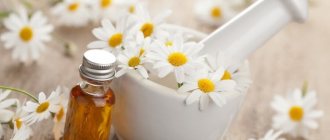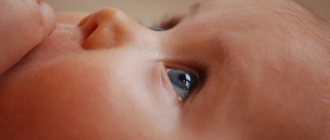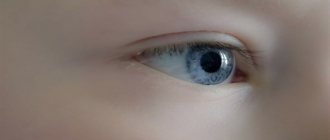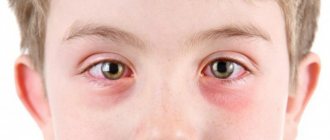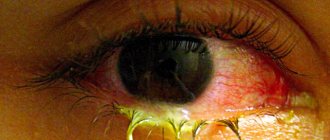The organs of vision belong to the sensory system and play a leading role in a person’s perception of the external environment and surrounding space, therefore visual pathologies must be treated immediately after the first symptoms appear. Conjunctivitis occupies a leading position among all eye diseases. This is an inflammation of the thin, clear membrane lining the outside of the eye and the back of the eyelids, called the conjunctiva. The main function of the conjunctiva of the eye is the production of tear fluid and mucous secretions necessary to moisturize the eye and maintain local protective functions.
Conjunctivitis in a 2 year old child
Conjunctivitis is most common in the younger age group, which includes children from 1 to 7 years old. Experts believe that the main cause of inflammatory processes at this age is poor personal hygiene (primarily hand hygiene), but in some cases, inflammation of the conjunctiva can be a complication of other infectious diseases, such as influenza or rotavirus infection. Treatment for children under 2 years of age is slightly different from those over 2 years of age, as many standard medications are only suitable for use in children over 2 years of age.
Photo of conjunctivitis in a child
Details about the types of conjunctivitis
Conjunctivitis, as mentioned above, is divided into three types based on the provocateurs of the disease:
- Allergy. Problems with the mucous membrane of the eye can begin due to an allergic reaction in a child. Symptoms of allergic conjunctivitis will be: frequent production of tears, redness of the eyes, while there will be no discharge of pus;
- Bacteria. In cases of bacterial diseases, the eye is affected by microorganisms, most often staphylococcus or chlamydia. The symptoms of bacterial conjunctivitis cause great discomfort, namely: itching, pus, which makes it difficult to open your eyes in the morning, as the eyelashes stick together, and the body temperature rises. It only takes three days for the bacteria to spread to both eyes. A child who suffers from bacterial conjunctivitis should be limited in communication with other children, because they may become infected;
- Viruses. Most often, a viral infection overtakes a child at a time when his immune system is weakened. Signs of viral conjunctivitis: severe photosensitivity, itchy eyes, no pus discharge, high body temperature.
In children under two years of age, the main causative agents of disease are parasites, improper functioning of the gastrointestinal tract, or inflammatory processes in the nose.
Why does conjunctivitis occur in a two-year-old child?
The most common cause of conjunctivitis is the child's curiosity and dirty hands. The baby constantly wants to explore new things, touches everything that comes to hand, and then, without washing himself, he can start rubbing his eyes. The main breeding ground for dangers for a baby is the sandbox, because there is not only dirt and sand, but also other people’s children’s toys, which may contain viruses and infections.
The main factors that cause a baby to develop conjunctivitis are:
- Dirt on hands;
- Allergic reaction;
- Viruses;
- Fungus;
- Microbes;
- The influence of wind and frosty weather.
Treatment of conjunctivitis
Typically, treatment of conjunctivitis at the age of two is reduced to eliminating the root cause of the disease, as well as eliminating the discomfort caused by the symptoms of the disease. Treatment usually consists of:
- Ointments and drops of antiseptic action, which are instilled into the eyes or placed under the child’s eyelid;
- Using medications against fungi or bacteria;
- Doctors also prescribe medications that strengthen the body. These medications most often include interferon, which makes it easier for the body to fight off infections.
All these medications should be taken only as prescribed by a doctor; self-medication can worsen the situation.
If the disease returns again, be sure to consult a doctor. You can't use the old recipe. In each new case of the disease, it is necessary to undergo a repeated examination, because The causes and specifics of the disease may vary.
Some doctors allow the use of traditional medicine in treatment. But only in combination with traditional methods. For example, many people treat conjunctivitis with brewed tea bags. This method can help relieve the symptoms of the disease, but it cannot cure. Therefore, it is important to contact a specialist so that he can prescribe treatment.
Treatment of conjunctivitis lasts only 1-2 weeks until complete recovery. But this is only possible if the parent managed to show his child to the doctor in a timely manner and followed all his recommendations.
In order to be completely sure that the disease is over (sometimes the symptoms go away, but after a while the disease can return again), you need to visit the doctor again.
Eye treatment for conjunctivitis
One of the most important steps in treating conjunctivitis is treating the eyes. For this, various means are used - decoctions of pharmaceutical plants, disinfectants, etc.
Children are often prescribed to treat their eyes with chamomile infusion. It’s easy to prepare such a solution – just add chopped chamomile to 200 ml of boiling water. The resulting liquid must be left for two hours, and then strained with gauze. The baby's eyes need to be treated about five times throughout the day. You need to moisten a cotton pad in the solution and start wiping your eyes, starting from the corner of the eye and moving towards the nose. All movements should be light. It is important to use clean cotton pads each time (a new one for each eye), otherwise the procedure will lose its meaning. Before each procedure, the parent must wash their hands thoroughly and then wipe them dry with a towel.
Chamomile decoction is often replaced with black tea, which is not strong. Black tea should be regular, without added flavorings or any impurities. In this case, eye treatment can be carried out not by rubbing, but using lotions. You need to soak cotton pads in tea leaves and apply them to your eyes for five minutes. This procedure should be done regularly throughout the day (at least three times a day).
Drug treatment for conjunctivitis
In cases where children develop conjunctivitis due to bacterial infections, doctors most often prescribe Albucid. This is the drug that experts recommend, because... it is easily tolerated by children, unlike many of its analogues. This medicine has a wide range of effects and easily deals with bacteria that cause the disease.
Reviews of Albucid
Valentina: this fall our entire family developed conjunctivitis (it all started with our youngest son), and then it came to our eldest daughter, me and my husband. This was not the first time the child brought this infection from kindergarten and, like last time, I went to the pharmacy to buy albucid. Drops help me and my husband in a day! The babies had to be treated a day longer, but this is a quick result. By the way, we dripped only twice a day. These drops have their drawbacks, of course, but with their quick healing effect it’s not so scary: after use, the eyes begin to burn for about thirty seconds, and a white coating appears on the eyelashes after use. Once opened, the drops can only be stored for a month, but given the ridiculous price for them, this is not a problem at all.
Tetracycline ointments are also used to treat conjunctivitis in children. In order to place such an ointment behind the eyelid, use a glass rod. This drug, like any other, must be prescribed by a doctor. Tetracycline ointments, as a rule, help overcome the disease in about a week. Most often they are prescribed for bacterial infections with purulent discharge.
Reviews of Tetracycline ointment
Tatyana: Hello! As soon as my two-year-old child was diagnosed with conjunctivitis, I immediately ran to the pharmacy for a proven remedy - Tetracycline ointment. The ointment itself does not look very pleasant - it is yellow in color and has a foul odor. But it is effective and does not sting, unlike many eye drops. The tip of the nose itself is comfortable, but I still squeezed the ointment out onto a cotton pad first and used it to apply the ointment to the child. There would be no point in doing this for an adult. The child did not have any allergies; after two uses, all the symptoms of conjunctivitis disappeared, but just in case, I used this ointment two more times. The price of the drug is small, but it works like a charm, so I’m not afraid to recommend it!
If a child develops conjunctivitis due to viral infections, virus-toxic eye drops are used. The most common drops with this effect are “Oftmalmoferon”. These drops can return the production of tears to normal and also quickly relieve redness of the eyes. These drops cannot be used without a doctor’s testimony, because... He will prescribe a dosage depending on the child’s individual indicators.
If conjunctivitis is caused by a fungus, the child is prescribed antifungal drugs. For fungal infections, the treatment process is long.
Rules for adding drugs
For most types of conjunctivitis, first of all, before instilling or applying the ointment, it is necessary to clean the surface of the eye from secretions, tears, mucus, and microparticles. In the treatment of children, clean boiled water and age-appropriate antiseptics (weak chamomile decoction, Furacilin solution) can be used for rinsing. For rinsing, it is recommended to use cotton swabs soaked in solution. The direction of cleaning for any manipulation is from the outer corner of the eye (from the temple) to the inner, while a new swab is taken for each eye. For conjunctivitis of viral and bacterial etiology, rinsing is prescribed up to 10-12 times a day, regardless of the prescribed frequency of medication use.
When instilling into the eyes, use containers with a soft spout or pipettes with a rounded end to reduce the possibility of injury. Even if only one eye is affected and there are no symptoms of inflammation in the second, medications are used for both eyes. When instilling, it is recommended to ensure that the medication gets on the mucous surface of the eye. It is optimal if the child can keep his eyes open, independently or with the help of an adult. What to do if a child closes his eyes? In this case, the drug is dripped into the inner corner of the eye and prevented from rubbing it off with your hands until the eyelids open.
The ointments are applied by retracting the lower eyelid, being careful when contacting the tip of the tube and the mucous membrane.
What consequences are expected if conjunctivitis in a child is not cured in time?
The disease itself is easily treated and is considered simple. But, as with any other disease, treatment is still required, and if timely assistance is not provided, serious problems may arise. In cases where the advice of doctors is neglected and the course of treatment is not completed, conjunctivitis may return, but in a chronic form.
The consequences may be different:
- The worst thing is that the child may go blind;
- Visual acuity may decrease, which cannot be restored later;
- Various formations may appear on the eyelids, which will bring both aesthetic and physical discomfort (scars, ulcers, etc.);
- the disease can develop into a chronic form.
Complications and consequences
Reference! If an infectious disease is untimely or incorrectly treated, there is a risk of developing such serious complications as:
- dry eye syndrome;
- blepharoconjunctivitis;
- entropion;
- decreased visual acuity;
- dystrophic changes in the conjunctiva;
- acquired strabismus;
- damage or clouding of the cornea;
- formation of infiltrates;
- partial or complete loss of vision.
Prevention of conjunctivitis
It will not be possible to completely exclude the possibility of conjunctivitis in a child aged 2 years, but it is still possible to minimize the risks by doing the following:
- Instill in your child the rules of hygiene from a very young age. He must wash his hands independently and also use towels and napkins designed specifically for him. Also, each adult should have his own towel;
- In rooms where the child spends most of his time, it is necessary to carry out wet cleaning and ventilate these rooms. Additionally, you can use humidifiers;
- Parents need to convey to their child the fact that they should not touch their face with dirty hands and try to explain what the consequences may be;
- If conjunctivitis does appear, it is necessary to limit the child’s contact with other children and adults so that other infections do not enter the body;
- The child should be limited in the time spent at the computer. Also, the baby should be taught to do eye exercises to relieve fatigue;
- To prevent your baby from having conjunctivitis, you need to monitor his immune system as a whole. Otherwise, the child will be susceptible to any diseases, for example, a cold, which often causes conjunctivitis. The immune system is strengthened through a healthy diet, regular walks in the fresh air and taking vitamin and mineral complexes;
- At the first signs of the disease, you should contact a specialist.
Note!
Conjunctivitis in a 3-year-old child is a serious eye disease. A common disease in many children. Parents shouldn't be afraid of this. We must act to protect our child and prevent the possibility of complications.
You should not risk your baby’s health and use medications on your own. Only a qualified ophthalmologist knows how to treat and will give effective recommendations.
Proper treatment is prevention. Teach your child the rules of hygiene: washing hands, using a personal towel, handkerchief. Don’t forget: it is necessary to disinfect toys (especially for playing outside), and do high-quality and timely wet cleaning around the house.
May 9, 2017Anastasia Graudina

